Auditing Report: Tests, Controls, and Substantive Procedures
VerifiedAdded on 2022/01/06
|9
|3353
|134
Report
AI Summary
This comprehensive auditing report delves into the core concepts of auditing, starting with its purpose of providing assurance on financial statements and the nature of audit processes. It explores limitations, ethical principles, and auditor independence, emphasizing the role of regulators. The report details the phases of an audit, from planning to reporting, and stresses the importance of understanding the entity and its environment. It covers the audit risk model, including inherent, control, and detection risks. Furthermore, it outlines appropriate tests of controls, substantive testing procedures, and the five audit assertions to ensure accurate financial reporting. The report highlights the auditor's responsibility in detecting fraud and the importance of professional judgment throughout the audit process.
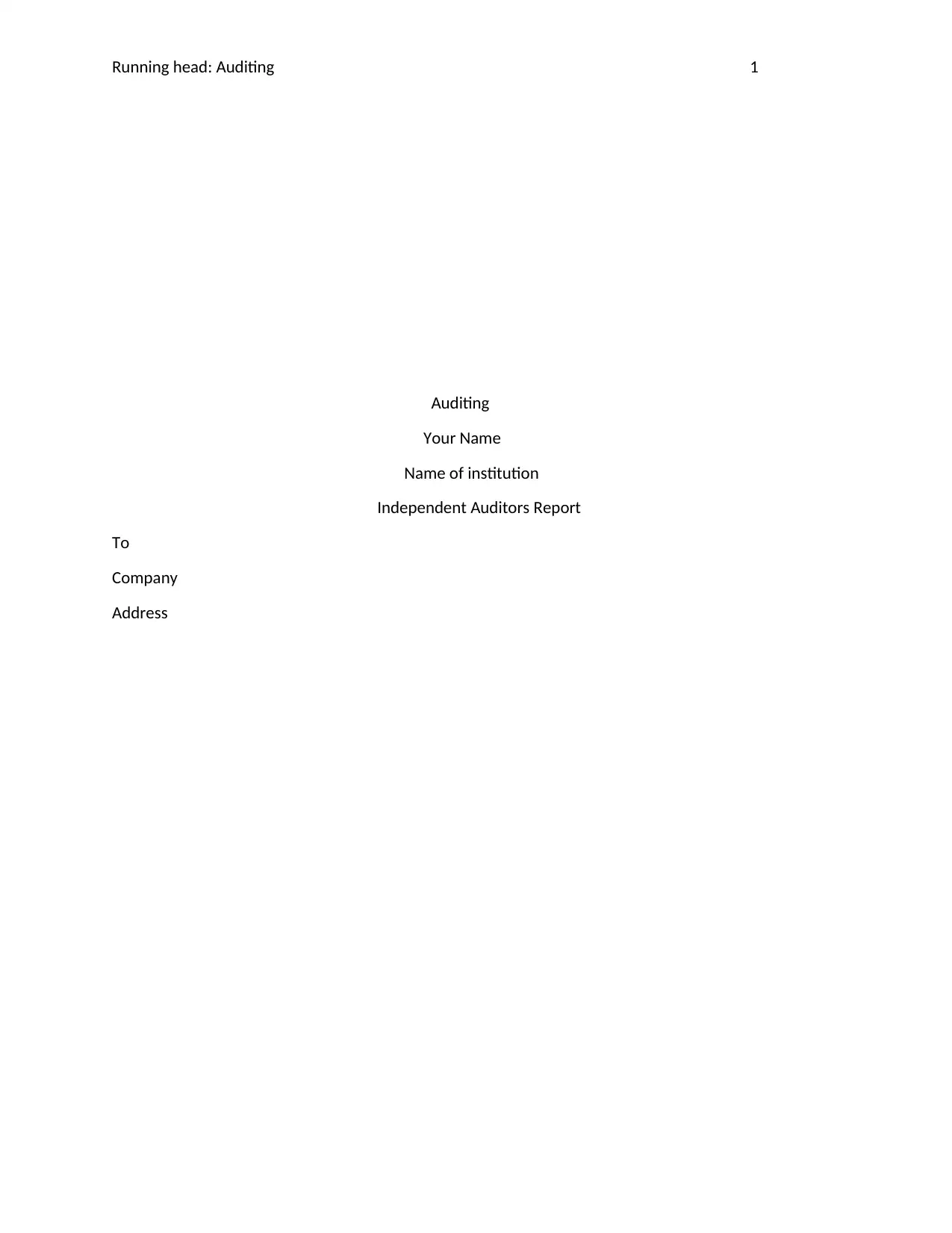
Running head: Auditing 1
Auditing
Your Name
Name of institution
Independent Auditors Report
To
Company
Address
Auditing
Your Name
Name of institution
Independent Auditors Report
To
Company
Address
Paraphrase This Document
Need a fresh take? Get an instant paraphrase of this document with our AI Paraphraser
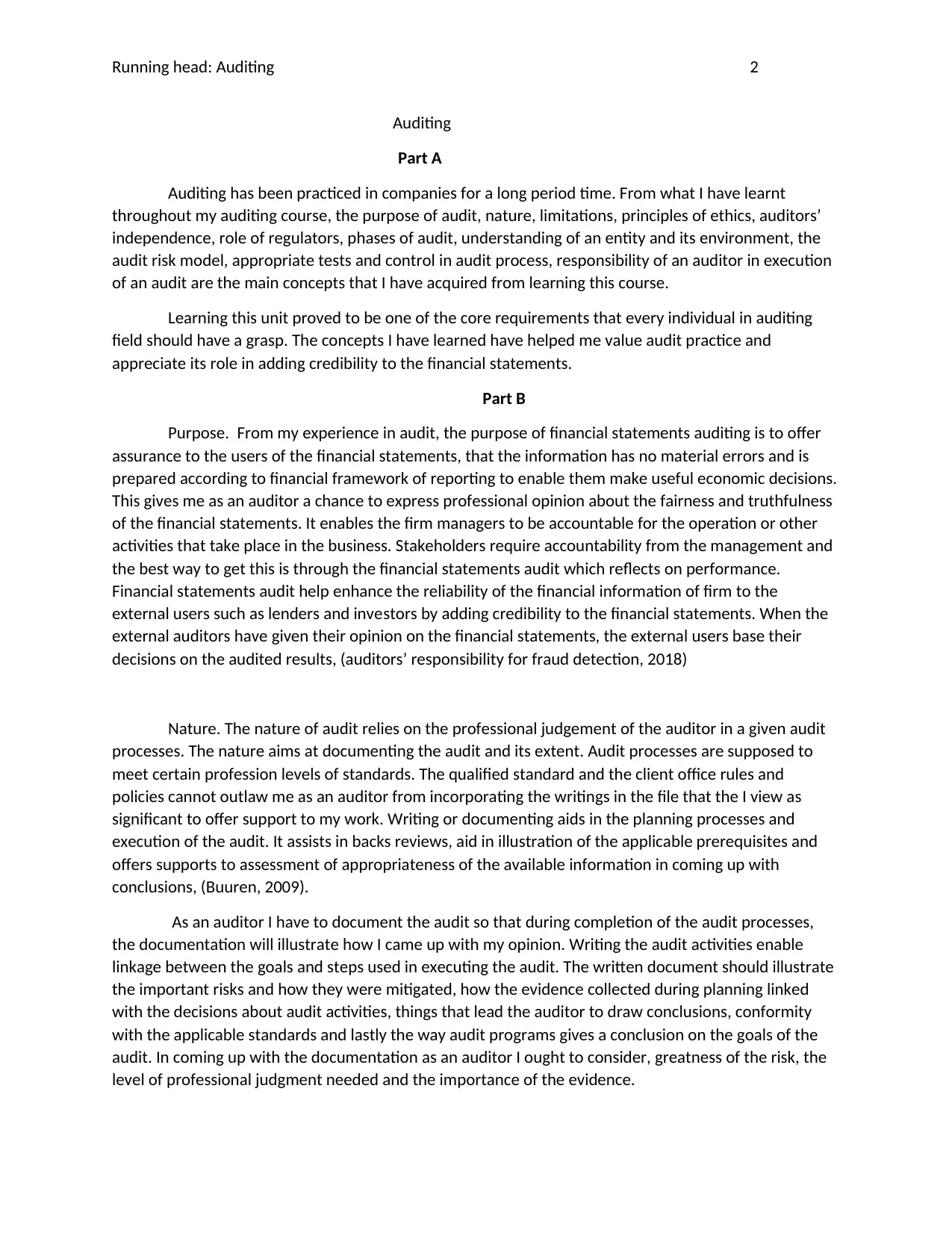
Running head: Auditing 2
Auditing
Part A
Auditing has been practiced in companies for a long period time. From what I have learnt
throughout my auditing course, the purpose of audit, nature, limitations, principles of ethics, auditors’
independence, role of regulators, phases of audit, understanding of an entity and its environment, the
audit risk model, appropriate tests and control in audit process, responsibility of an auditor in execution
of an audit are the main concepts that I have acquired from learning this course.
Learning this unit proved to be one of the core requirements that every individual in auditing
field should have a grasp. The concepts I have learned have helped me value audit practice and
appreciate its role in adding credibility to the financial statements.
Part B
Purpose. From my experience in audit, the purpose of financial statements auditing is to offer
assurance to the users of the financial statements, that the information has no material errors and is
prepared according to financial framework of reporting to enable them make useful economic decisions.
This gives me as an auditor a chance to express professional opinion about the fairness and truthfulness
of the financial statements. It enables the firm managers to be accountable for the operation or other
activities that take place in the business. Stakeholders require accountability from the management and
the best way to get this is through the financial statements audit which reflects on performance.
Financial statements audit help enhance the reliability of the financial information of firm to the
external users such as lenders and investors by adding credibility to the financial statements. When the
external auditors have given their opinion on the financial statements, the external users base their
decisions on the audited results, (auditors’ responsibility for fraud detection, 2018)
Nature. The nature of audit relies on the professional judgement of the auditor in a given audit
processes. The nature aims at documenting the audit and its extent. Audit processes are supposed to
meet certain profession levels of standards. The qualified standard and the client office rules and
policies cannot outlaw me as an auditor from incorporating the writings in the file that the I view as
significant to offer support to my work. Writing or documenting aids in the planning processes and
execution of the audit. It assists in backs reviews, aid in illustration of the applicable prerequisites and
offers supports to assessment of appropriateness of the available information in coming up with
conclusions, (Buuren, 2009).
As an auditor I have to document the audit so that during completion of the audit processes,
the documentation will illustrate how I came up with my opinion. Writing the audit activities enable
linkage between the goals and steps used in executing the audit. The written document should illustrate
the important risks and how they were mitigated, how the evidence collected during planning linked
with the decisions about audit activities, things that lead the auditor to draw conclusions, conformity
with the applicable standards and lastly the way audit programs gives a conclusion on the goals of the
audit. In coming up with the documentation as an auditor I ought to consider, greatness of the risk, the
level of professional judgment needed and the importance of the evidence.
Auditing
Part A
Auditing has been practiced in companies for a long period time. From what I have learnt
throughout my auditing course, the purpose of audit, nature, limitations, principles of ethics, auditors’
independence, role of regulators, phases of audit, understanding of an entity and its environment, the
audit risk model, appropriate tests and control in audit process, responsibility of an auditor in execution
of an audit are the main concepts that I have acquired from learning this course.
Learning this unit proved to be one of the core requirements that every individual in auditing
field should have a grasp. The concepts I have learned have helped me value audit practice and
appreciate its role in adding credibility to the financial statements.
Part B
Purpose. From my experience in audit, the purpose of financial statements auditing is to offer
assurance to the users of the financial statements, that the information has no material errors and is
prepared according to financial framework of reporting to enable them make useful economic decisions.
This gives me as an auditor a chance to express professional opinion about the fairness and truthfulness
of the financial statements. It enables the firm managers to be accountable for the operation or other
activities that take place in the business. Stakeholders require accountability from the management and
the best way to get this is through the financial statements audit which reflects on performance.
Financial statements audit help enhance the reliability of the financial information of firm to the
external users such as lenders and investors by adding credibility to the financial statements. When the
external auditors have given their opinion on the financial statements, the external users base their
decisions on the audited results, (auditors’ responsibility for fraud detection, 2018)
Nature. The nature of audit relies on the professional judgement of the auditor in a given audit
processes. The nature aims at documenting the audit and its extent. Audit processes are supposed to
meet certain profession levels of standards. The qualified standard and the client office rules and
policies cannot outlaw me as an auditor from incorporating the writings in the file that the I view as
significant to offer support to my work. Writing or documenting aids in the planning processes and
execution of the audit. It assists in backs reviews, aid in illustration of the applicable prerequisites and
offers supports to assessment of appropriateness of the available information in coming up with
conclusions, (Buuren, 2009).
As an auditor I have to document the audit so that during completion of the audit processes,
the documentation will illustrate how I came up with my opinion. Writing the audit activities enable
linkage between the goals and steps used in executing the audit. The written document should illustrate
the important risks and how they were mitigated, how the evidence collected during planning linked
with the decisions about audit activities, things that lead the auditor to draw conclusions, conformity
with the applicable standards and lastly the way audit programs gives a conclusion on the goals of the
audit. In coming up with the documentation as an auditor I ought to consider, greatness of the risk, the
level of professional judgment needed and the importance of the evidence.
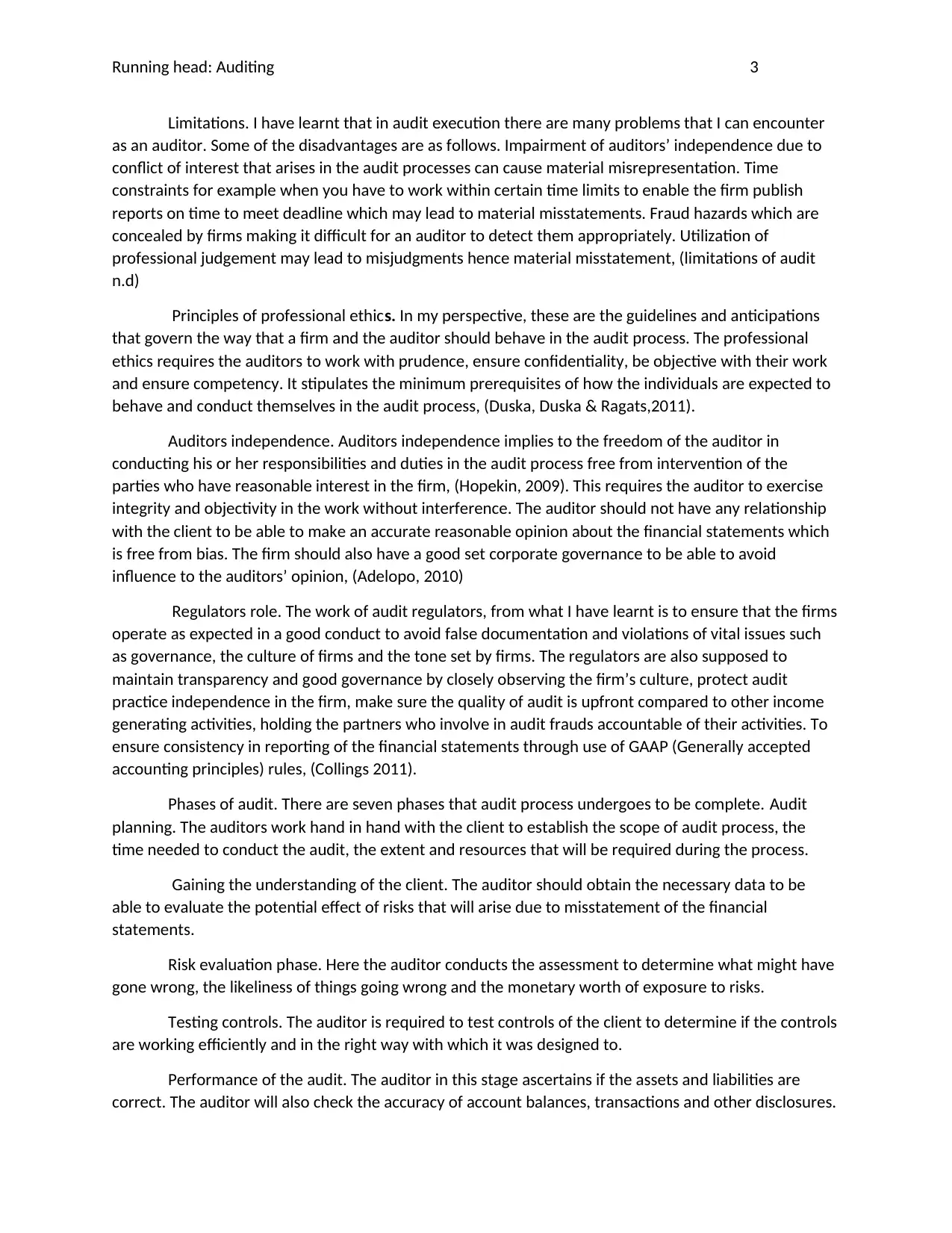
Running head: Auditing 3
Limitations. I have learnt that in audit execution there are many problems that I can encounter
as an auditor. Some of the disadvantages are as follows. Impairment of auditors’ independence due to
conflict of interest that arises in the audit processes can cause material misrepresentation. Time
constraints for example when you have to work within certain time limits to enable the firm publish
reports on time to meet deadline which may lead to material misstatements. Fraud hazards which are
concealed by firms making it difficult for an auditor to detect them appropriately. Utilization of
professional judgement may lead to misjudgments hence material misstatement, (limitations of audit
n.d)
Principles of professional ethics. In my perspective, these are the guidelines and anticipations
that govern the way that a firm and the auditor should behave in the audit process. The professional
ethics requires the auditors to work with prudence, ensure confidentiality, be objective with their work
and ensure competency. It stipulates the minimum prerequisites of how the individuals are expected to
behave and conduct themselves in the audit process, (Duska, Duska & Ragats,2011).
Auditors independence. Auditors independence implies to the freedom of the auditor in
conducting his or her responsibilities and duties in the audit process free from intervention of the
parties who have reasonable interest in the firm, (Hopekin, 2009). This requires the auditor to exercise
integrity and objectivity in the work without interference. The auditor should not have any relationship
with the client to be able to make an accurate reasonable opinion about the financial statements which
is free from bias. The firm should also have a good set corporate governance to be able to avoid
influence to the auditors’ opinion, (Adelopo, 2010)
Regulators role. The work of audit regulators, from what I have learnt is to ensure that the firms
operate as expected in a good conduct to avoid false documentation and violations of vital issues such
as governance, the culture of firms and the tone set by firms. The regulators are also supposed to
maintain transparency and good governance by closely observing the firm’s culture, protect audit
practice independence in the firm, make sure the quality of audit is upfront compared to other income
generating activities, holding the partners who involve in audit frauds accountable of their activities. To
ensure consistency in reporting of the financial statements through use of GAAP (Generally accepted
accounting principles) rules, (Collings 2011).
Phases of audit. There are seven phases that audit process undergoes to be complete. Audit
planning. The auditors work hand in hand with the client to establish the scope of audit process, the
time needed to conduct the audit, the extent and resources that will be required during the process.
Gaining the understanding of the client. The auditor should obtain the necessary data to be
able to evaluate the potential effect of risks that will arise due to misstatement of the financial
statements.
Risk evaluation phase. Here the auditor conducts the assessment to determine what might have
gone wrong, the likeliness of things going wrong and the monetary worth of exposure to risks.
Testing controls. The auditor is required to test controls of the client to determine if the controls
are working efficiently and in the right way with which it was designed to.
Performance of the audit. The auditor in this stage ascertains if the assets and liabilities are
correct. The auditor will also check the accuracy of account balances, transactions and other disclosures.
Limitations. I have learnt that in audit execution there are many problems that I can encounter
as an auditor. Some of the disadvantages are as follows. Impairment of auditors’ independence due to
conflict of interest that arises in the audit processes can cause material misrepresentation. Time
constraints for example when you have to work within certain time limits to enable the firm publish
reports on time to meet deadline which may lead to material misstatements. Fraud hazards which are
concealed by firms making it difficult for an auditor to detect them appropriately. Utilization of
professional judgement may lead to misjudgments hence material misstatement, (limitations of audit
n.d)
Principles of professional ethics. In my perspective, these are the guidelines and anticipations
that govern the way that a firm and the auditor should behave in the audit process. The professional
ethics requires the auditors to work with prudence, ensure confidentiality, be objective with their work
and ensure competency. It stipulates the minimum prerequisites of how the individuals are expected to
behave and conduct themselves in the audit process, (Duska, Duska & Ragats,2011).
Auditors independence. Auditors independence implies to the freedom of the auditor in
conducting his or her responsibilities and duties in the audit process free from intervention of the
parties who have reasonable interest in the firm, (Hopekin, 2009). This requires the auditor to exercise
integrity and objectivity in the work without interference. The auditor should not have any relationship
with the client to be able to make an accurate reasonable opinion about the financial statements which
is free from bias. The firm should also have a good set corporate governance to be able to avoid
influence to the auditors’ opinion, (Adelopo, 2010)
Regulators role. The work of audit regulators, from what I have learnt is to ensure that the firms
operate as expected in a good conduct to avoid false documentation and violations of vital issues such
as governance, the culture of firms and the tone set by firms. The regulators are also supposed to
maintain transparency and good governance by closely observing the firm’s culture, protect audit
practice independence in the firm, make sure the quality of audit is upfront compared to other income
generating activities, holding the partners who involve in audit frauds accountable of their activities. To
ensure consistency in reporting of the financial statements through use of GAAP (Generally accepted
accounting principles) rules, (Collings 2011).
Phases of audit. There are seven phases that audit process undergoes to be complete. Audit
planning. The auditors work hand in hand with the client to establish the scope of audit process, the
time needed to conduct the audit, the extent and resources that will be required during the process.
Gaining the understanding of the client. The auditor should obtain the necessary data to be
able to evaluate the potential effect of risks that will arise due to misstatement of the financial
statements.
Risk evaluation phase. Here the auditor conducts the assessment to determine what might have
gone wrong, the likeliness of things going wrong and the monetary worth of exposure to risks.
Testing controls. The auditor is required to test controls of the client to determine if the controls
are working efficiently and in the right way with which it was designed to.
Performance of the audit. The auditor in this stage ascertains if the assets and liabilities are
correct. The auditor will also check the accuracy of account balances, transactions and other disclosures.
⊘ This is a preview!⊘
Do you want full access?
Subscribe today to unlock all pages.

Trusted by 1+ million students worldwide
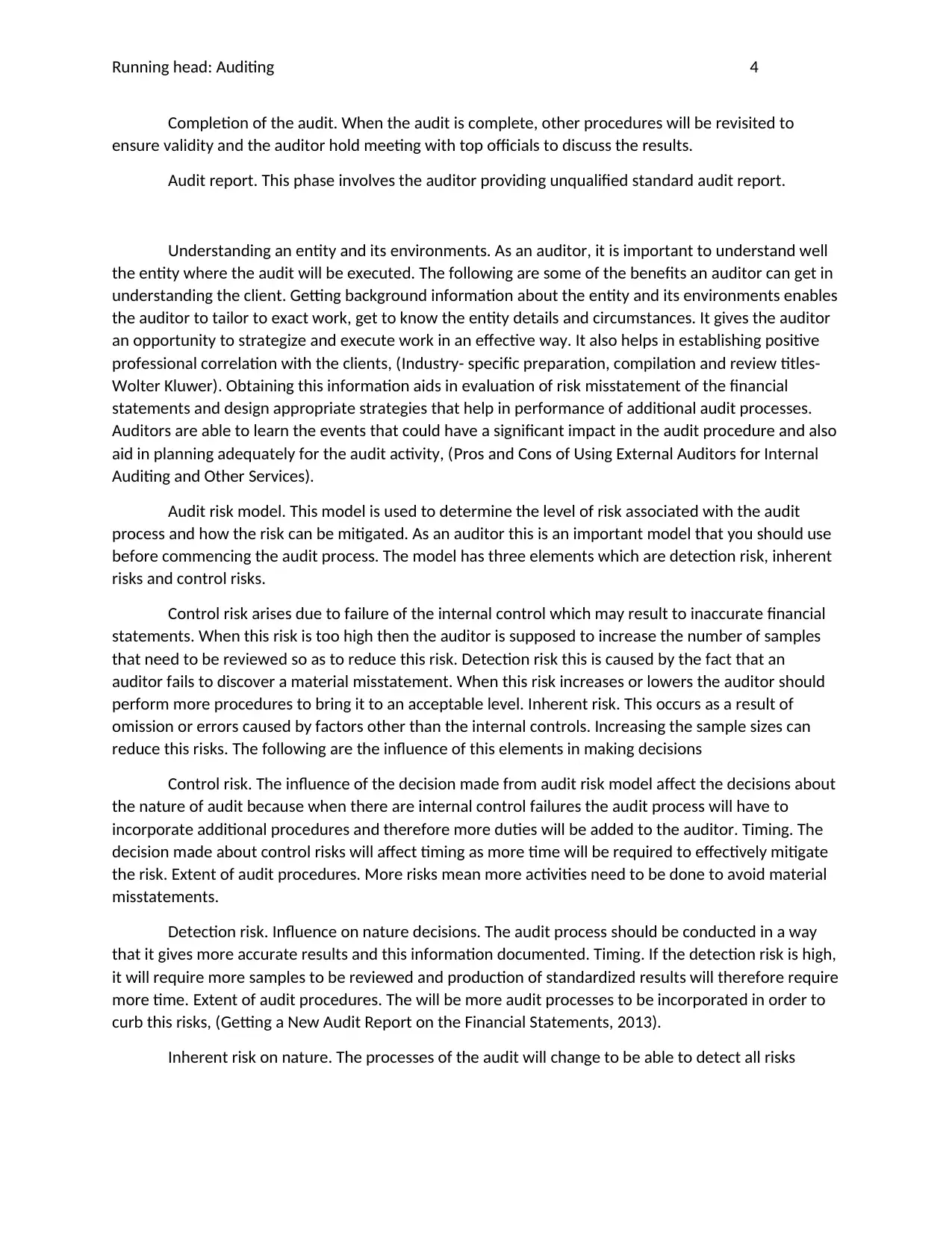
Running head: Auditing 4
Completion of the audit. When the audit is complete, other procedures will be revisited to
ensure validity and the auditor hold meeting with top officials to discuss the results.
Audit report. This phase involves the auditor providing unqualified standard audit report.
Understanding an entity and its environments. As an auditor, it is important to understand well
the entity where the audit will be executed. The following are some of the benefits an auditor can get in
understanding the client. Getting background information about the entity and its environments enables
the auditor to tailor to exact work, get to know the entity details and circumstances. It gives the auditor
an opportunity to strategize and execute work in an effective way. It also helps in establishing positive
professional correlation with the clients, (Industry- specific preparation, compilation and review titles-
Wolter Kluwer). Obtaining this information aids in evaluation of risk misstatement of the financial
statements and design appropriate strategies that help in performance of additional audit processes.
Auditors are able to learn the events that could have a significant impact in the audit procedure and also
aid in planning adequately for the audit activity, (Pros and Cons of Using External Auditors for Internal
Auditing and Other Services).
Audit risk model. This model is used to determine the level of risk associated with the audit
process and how the risk can be mitigated. As an auditor this is an important model that you should use
before commencing the audit process. The model has three elements which are detection risk, inherent
risks and control risks.
Control risk arises due to failure of the internal control which may result to inaccurate financial
statements. When this risk is too high then the auditor is supposed to increase the number of samples
that need to be reviewed so as to reduce this risk. Detection risk this is caused by the fact that an
auditor fails to discover a material misstatement. When this risk increases or lowers the auditor should
perform more procedures to bring it to an acceptable level. Inherent risk. This occurs as a result of
omission or errors caused by factors other than the internal controls. Increasing the sample sizes can
reduce this risks. The following are the influence of this elements in making decisions
Control risk. The influence of the decision made from audit risk model affect the decisions about
the nature of audit because when there are internal control failures the audit process will have to
incorporate additional procedures and therefore more duties will be added to the auditor. Timing. The
decision made about control risks will affect timing as more time will be required to effectively mitigate
the risk. Extent of audit procedures. More risks mean more activities need to be done to avoid material
misstatements.
Detection risk. Influence on nature decisions. The audit process should be conducted in a way
that it gives more accurate results and this information documented. Timing. If the detection risk is high,
it will require more samples to be reviewed and production of standardized results will therefore require
more time. Extent of audit procedures. The will be more audit processes to be incorporated in order to
curb this risks, (Getting a New Audit Report on the Financial Statements, 2013).
Inherent risk on nature. The processes of the audit will change to be able to detect all risks
Completion of the audit. When the audit is complete, other procedures will be revisited to
ensure validity and the auditor hold meeting with top officials to discuss the results.
Audit report. This phase involves the auditor providing unqualified standard audit report.
Understanding an entity and its environments. As an auditor, it is important to understand well
the entity where the audit will be executed. The following are some of the benefits an auditor can get in
understanding the client. Getting background information about the entity and its environments enables
the auditor to tailor to exact work, get to know the entity details and circumstances. It gives the auditor
an opportunity to strategize and execute work in an effective way. It also helps in establishing positive
professional correlation with the clients, (Industry- specific preparation, compilation and review titles-
Wolter Kluwer). Obtaining this information aids in evaluation of risk misstatement of the financial
statements and design appropriate strategies that help in performance of additional audit processes.
Auditors are able to learn the events that could have a significant impact in the audit procedure and also
aid in planning adequately for the audit activity, (Pros and Cons of Using External Auditors for Internal
Auditing and Other Services).
Audit risk model. This model is used to determine the level of risk associated with the audit
process and how the risk can be mitigated. As an auditor this is an important model that you should use
before commencing the audit process. The model has three elements which are detection risk, inherent
risks and control risks.
Control risk arises due to failure of the internal control which may result to inaccurate financial
statements. When this risk is too high then the auditor is supposed to increase the number of samples
that need to be reviewed so as to reduce this risk. Detection risk this is caused by the fact that an
auditor fails to discover a material misstatement. When this risk increases or lowers the auditor should
perform more procedures to bring it to an acceptable level. Inherent risk. This occurs as a result of
omission or errors caused by factors other than the internal controls. Increasing the sample sizes can
reduce this risks. The following are the influence of this elements in making decisions
Control risk. The influence of the decision made from audit risk model affect the decisions about
the nature of audit because when there are internal control failures the audit process will have to
incorporate additional procedures and therefore more duties will be added to the auditor. Timing. The
decision made about control risks will affect timing as more time will be required to effectively mitigate
the risk. Extent of audit procedures. More risks mean more activities need to be done to avoid material
misstatements.
Detection risk. Influence on nature decisions. The audit process should be conducted in a way
that it gives more accurate results and this information documented. Timing. If the detection risk is high,
it will require more samples to be reviewed and production of standardized results will therefore require
more time. Extent of audit procedures. The will be more audit processes to be incorporated in order to
curb this risks, (Getting a New Audit Report on the Financial Statements, 2013).
Inherent risk on nature. The processes of the audit will change to be able to detect all risks
Paraphrase This Document
Need a fresh take? Get an instant paraphrase of this document with our AI Paraphraser
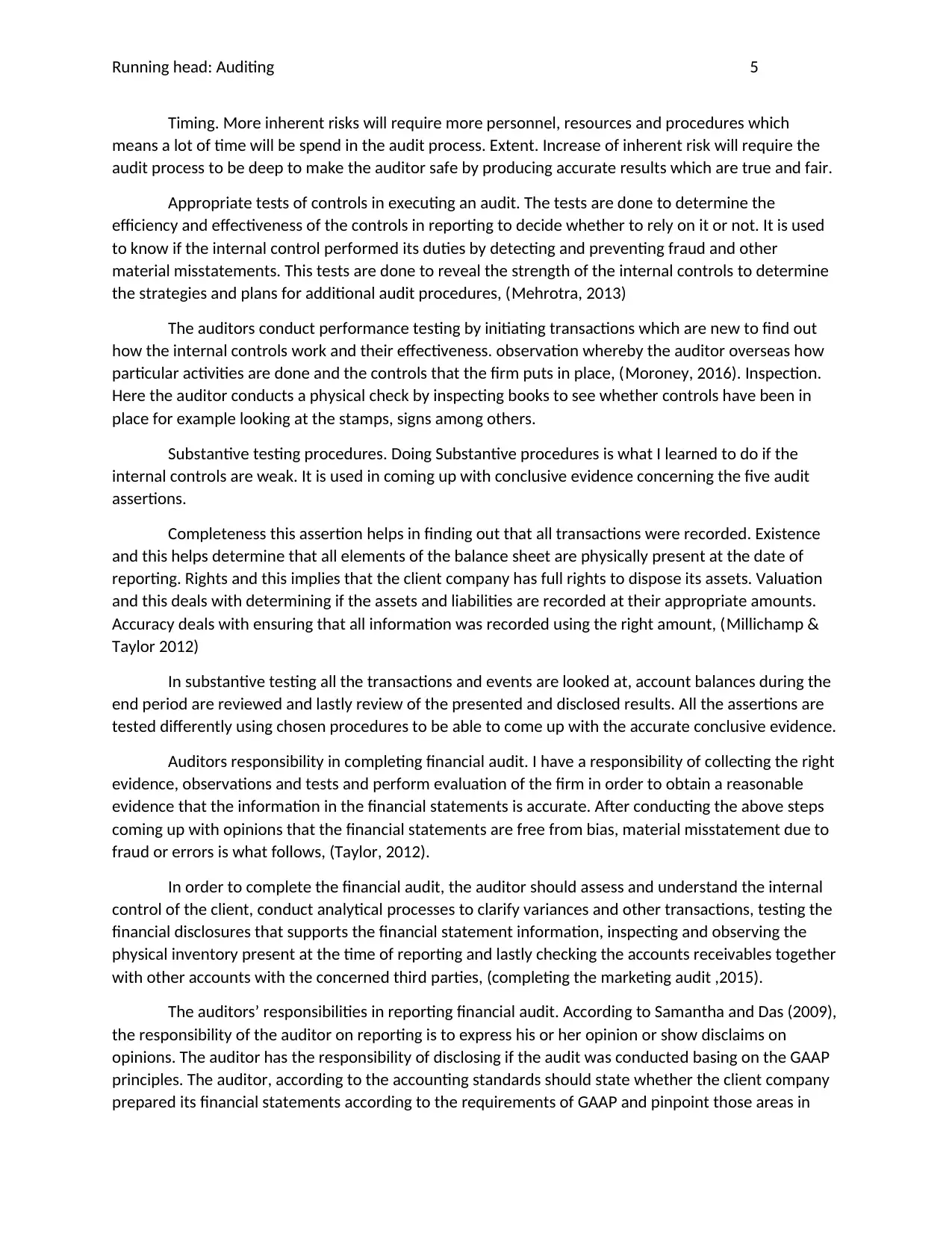
Running head: Auditing 5
Timing. More inherent risks will require more personnel, resources and procedures which
means a lot of time will be spend in the audit process. Extent. Increase of inherent risk will require the
audit process to be deep to make the auditor safe by producing accurate results which are true and fair.
Appropriate tests of controls in executing an audit. The tests are done to determine the
efficiency and effectiveness of the controls in reporting to decide whether to rely on it or not. It is used
to know if the internal control performed its duties by detecting and preventing fraud and other
material misstatements. This tests are done to reveal the strength of the internal controls to determine
the strategies and plans for additional audit procedures, (Mehrotra, 2013)
The auditors conduct performance testing by initiating transactions which are new to find out
how the internal controls work and their effectiveness. observation whereby the auditor overseas how
particular activities are done and the controls that the firm puts in place, (Moroney, 2016). Inspection.
Here the auditor conducts a physical check by inspecting books to see whether controls have been in
place for example looking at the stamps, signs among others.
Substantive testing procedures. Doing Substantive procedures is what I learned to do if the
internal controls are weak. It is used in coming up with conclusive evidence concerning the five audit
assertions.
Completeness this assertion helps in finding out that all transactions were recorded. Existence
and this helps determine that all elements of the balance sheet are physically present at the date of
reporting. Rights and this implies that the client company has full rights to dispose its assets. Valuation
and this deals with determining if the assets and liabilities are recorded at their appropriate amounts.
Accuracy deals with ensuring that all information was recorded using the right amount, (Millichamp &
Taylor 2012)
In substantive testing all the transactions and events are looked at, account balances during the
end period are reviewed and lastly review of the presented and disclosed results. All the assertions are
tested differently using chosen procedures to be able to come up with the accurate conclusive evidence.
Auditors responsibility in completing financial audit. I have a responsibility of collecting the right
evidence, observations and tests and perform evaluation of the firm in order to obtain a reasonable
evidence that the information in the financial statements is accurate. After conducting the above steps
coming up with opinions that the financial statements are free from bias, material misstatement due to
fraud or errors is what follows, (Taylor, 2012).
In order to complete the financial audit, the auditor should assess and understand the internal
control of the client, conduct analytical processes to clarify variances and other transactions, testing the
financial disclosures that supports the financial statement information, inspecting and observing the
physical inventory present at the time of reporting and lastly checking the accounts receivables together
with other accounts with the concerned third parties, (completing the marketing audit ,2015).
The auditors’ responsibilities in reporting financial audit. According to Samantha and Das (2009),
the responsibility of the auditor on reporting is to express his or her opinion or show disclaims on
opinions. The auditor has the responsibility of disclosing if the audit was conducted basing on the GAAP
principles. The auditor, according to the accounting standards should state whether the client company
prepared its financial statements according to the requirements of GAAP and pinpoint those areas in
Timing. More inherent risks will require more personnel, resources and procedures which
means a lot of time will be spend in the audit process. Extent. Increase of inherent risk will require the
audit process to be deep to make the auditor safe by producing accurate results which are true and fair.
Appropriate tests of controls in executing an audit. The tests are done to determine the
efficiency and effectiveness of the controls in reporting to decide whether to rely on it or not. It is used
to know if the internal control performed its duties by detecting and preventing fraud and other
material misstatements. This tests are done to reveal the strength of the internal controls to determine
the strategies and plans for additional audit procedures, (Mehrotra, 2013)
The auditors conduct performance testing by initiating transactions which are new to find out
how the internal controls work and their effectiveness. observation whereby the auditor overseas how
particular activities are done and the controls that the firm puts in place, (Moroney, 2016). Inspection.
Here the auditor conducts a physical check by inspecting books to see whether controls have been in
place for example looking at the stamps, signs among others.
Substantive testing procedures. Doing Substantive procedures is what I learned to do if the
internal controls are weak. It is used in coming up with conclusive evidence concerning the five audit
assertions.
Completeness this assertion helps in finding out that all transactions were recorded. Existence
and this helps determine that all elements of the balance sheet are physically present at the date of
reporting. Rights and this implies that the client company has full rights to dispose its assets. Valuation
and this deals with determining if the assets and liabilities are recorded at their appropriate amounts.
Accuracy deals with ensuring that all information was recorded using the right amount, (Millichamp &
Taylor 2012)
In substantive testing all the transactions and events are looked at, account balances during the
end period are reviewed and lastly review of the presented and disclosed results. All the assertions are
tested differently using chosen procedures to be able to come up with the accurate conclusive evidence.
Auditors responsibility in completing financial audit. I have a responsibility of collecting the right
evidence, observations and tests and perform evaluation of the firm in order to obtain a reasonable
evidence that the information in the financial statements is accurate. After conducting the above steps
coming up with opinions that the financial statements are free from bias, material misstatement due to
fraud or errors is what follows, (Taylor, 2012).
In order to complete the financial audit, the auditor should assess and understand the internal
control of the client, conduct analytical processes to clarify variances and other transactions, testing the
financial disclosures that supports the financial statement information, inspecting and observing the
physical inventory present at the time of reporting and lastly checking the accounts receivables together
with other accounts with the concerned third parties, (completing the marketing audit ,2015).
The auditors’ responsibilities in reporting financial audit. According to Samantha and Das (2009),
the responsibility of the auditor on reporting is to express his or her opinion or show disclaims on
opinions. The auditor has the responsibility of disclosing if the audit was conducted basing on the GAAP
principles. The auditor, according to the accounting standards should state whether the client company
prepared its financial statements according to the requirements of GAAP and pinpoint those areas in
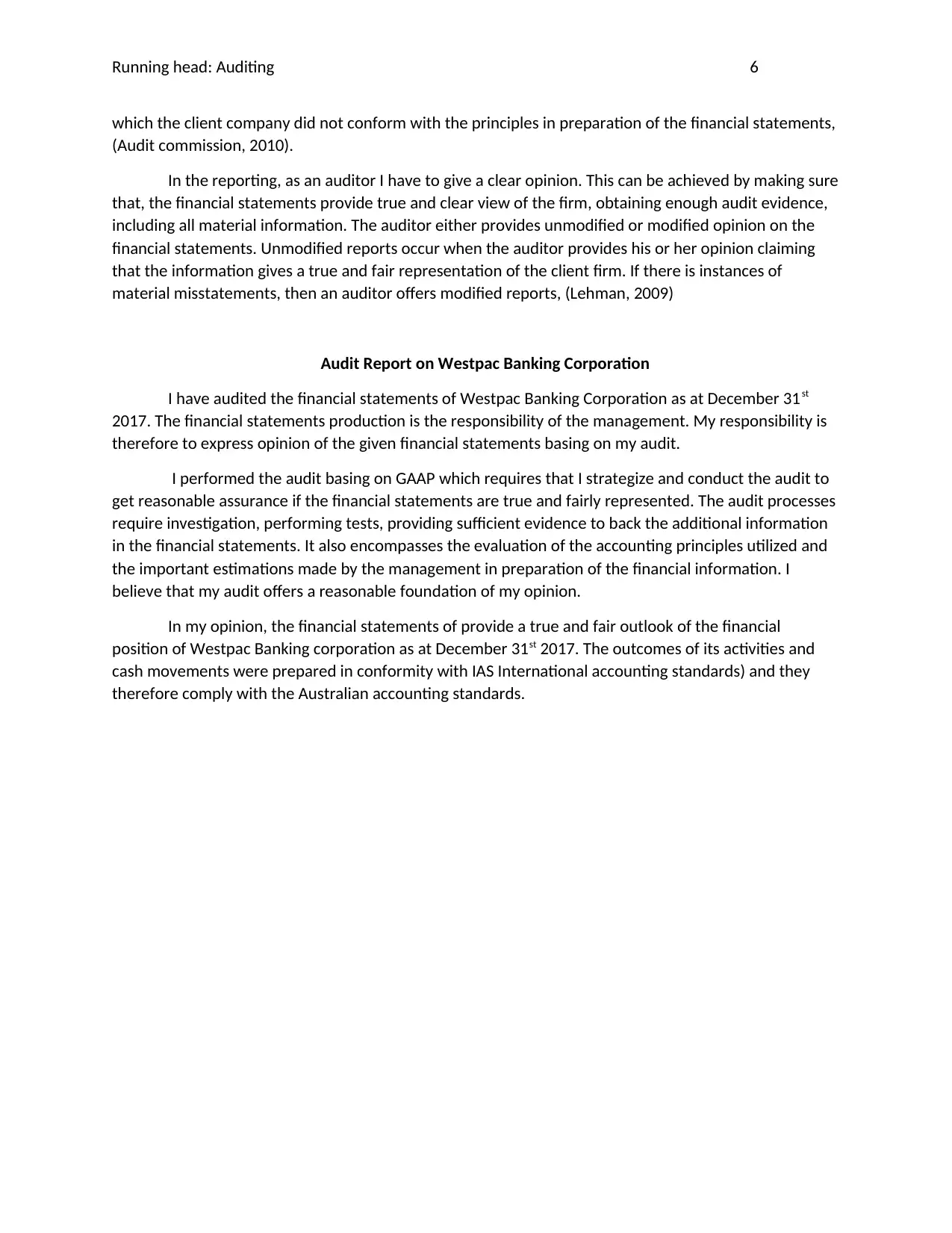
Running head: Auditing 6
which the client company did not conform with the principles in preparation of the financial statements,
(Audit commission, 2010).
In the reporting, as an auditor I have to give a clear opinion. This can be achieved by making sure
that, the financial statements provide true and clear view of the firm, obtaining enough audit evidence,
including all material information. The auditor either provides unmodified or modified opinion on the
financial statements. Unmodified reports occur when the auditor provides his or her opinion claiming
that the information gives a true and fair representation of the client firm. If there is instances of
material misstatements, then an auditor offers modified reports, (Lehman, 2009)
Audit Report on Westpac Banking Corporation
I have audited the financial statements of Westpac Banking Corporation as at December 31st
2017. The financial statements production is the responsibility of the management. My responsibility is
therefore to express opinion of the given financial statements basing on my audit.
I performed the audit basing on GAAP which requires that I strategize and conduct the audit to
get reasonable assurance if the financial statements are true and fairly represented. The audit processes
require investigation, performing tests, providing sufficient evidence to back the additional information
in the financial statements. It also encompasses the evaluation of the accounting principles utilized and
the important estimations made by the management in preparation of the financial information. I
believe that my audit offers a reasonable foundation of my opinion.
In my opinion, the financial statements of provide a true and fair outlook of the financial
position of Westpac Banking corporation as at December 31st 2017. The outcomes of its activities and
cash movements were prepared in conformity with IAS International accounting standards) and they
therefore comply with the Australian accounting standards.
which the client company did not conform with the principles in preparation of the financial statements,
(Audit commission, 2010).
In the reporting, as an auditor I have to give a clear opinion. This can be achieved by making sure
that, the financial statements provide true and clear view of the firm, obtaining enough audit evidence,
including all material information. The auditor either provides unmodified or modified opinion on the
financial statements. Unmodified reports occur when the auditor provides his or her opinion claiming
that the information gives a true and fair representation of the client firm. If there is instances of
material misstatements, then an auditor offers modified reports, (Lehman, 2009)
Audit Report on Westpac Banking Corporation
I have audited the financial statements of Westpac Banking Corporation as at December 31st
2017. The financial statements production is the responsibility of the management. My responsibility is
therefore to express opinion of the given financial statements basing on my audit.
I performed the audit basing on GAAP which requires that I strategize and conduct the audit to
get reasonable assurance if the financial statements are true and fairly represented. The audit processes
require investigation, performing tests, providing sufficient evidence to back the additional information
in the financial statements. It also encompasses the evaluation of the accounting principles utilized and
the important estimations made by the management in preparation of the financial information. I
believe that my audit offers a reasonable foundation of my opinion.
In my opinion, the financial statements of provide a true and fair outlook of the financial
position of Westpac Banking corporation as at December 31st 2017. The outcomes of its activities and
cash movements were prepared in conformity with IAS International accounting standards) and they
therefore comply with the Australian accounting standards.
⊘ This is a preview!⊘
Do you want full access?
Subscribe today to unlock all pages.

Trusted by 1+ million students worldwide
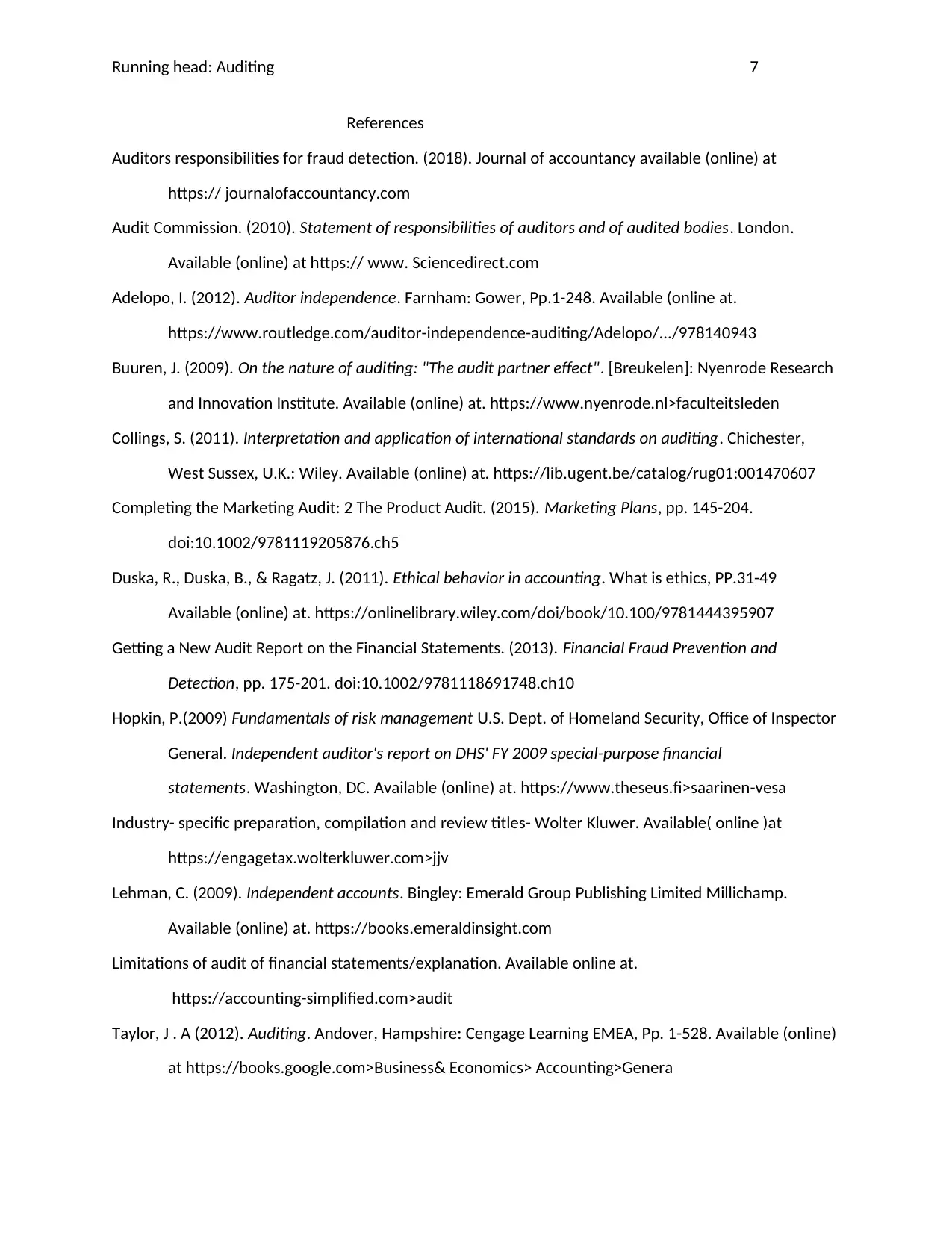
Running head: Auditing 7
References
Auditors responsibilities for fraud detection. (2018). Journal of accountancy available (online) at
https:// journalofaccountancy.com
Audit Commission. (2010). Statement of responsibilities of auditors and of audited bodies. London.
Available (online) at https:// www. Sciencedirect.com
Adelopo, I. (2012). Auditor independence. Farnham: Gower, Pp.1-248. Available (online at.
https://www.routledge.com/auditor-independence-auditing/Adelopo/.../978140943
Buuren, J. (2009). On the nature of auditing: "The audit partner effect". [Breukelen]: Nyenrode Research
and Innovation Institute. Available (online) at. https://www.nyenrode.nl>faculteitsleden
Collings, S. (2011). Interpretation and application of international standards on auditing. Chichester,
West Sussex, U.K.: Wiley. Available (online) at. https://lib.ugent.be/catalog/rug01:001470607
Completing the Marketing Audit: 2 The Product Audit. (2015). Marketing Plans, pp. 145-204.
doi:10.1002/9781119205876.ch5
Duska, R., Duska, B., & Ragatz, J. (2011). Ethical behavior in accounting. What is ethics, PP.31-49
Available (online) at. https://onlinelibrary.wiley.com/doi/book/10.100/9781444395907
Getting a New Audit Report on the Financial Statements. (2013). Financial Fraud Prevention and
Detection, pp. 175-201. doi:10.1002/9781118691748.ch10
Hopkin, P.(2009) Fundamentals of risk management U.S. Dept. of Homeland Security, Office of Inspector
General. Independent auditor's report on DHS' FY 2009 special-purpose financial
statements. Washington, DC. Available (online) at. https://www.theseus.fi>saarinen-vesa
Industry- specific preparation, compilation and review titles- Wolter Kluwer. Available( online )at
https://engagetax.wolterkluwer.com>jjv
Lehman, C. (2009). Independent accounts. Bingley: Emerald Group Publishing Limited Millichamp.
Available (online) at. https://books.emeraldinsight.com
Limitations of audit of financial statements/explanation. Available online at.
https://accounting-simplified.com>audit
Taylor, J . A (2012). Auditing. Andover, Hampshire: Cengage Learning EMEA, Pp. 1-528. Available (online)
at https://books.google.com>Business& Economics> Accounting>Genera
References
Auditors responsibilities for fraud detection. (2018). Journal of accountancy available (online) at
https:// journalofaccountancy.com
Audit Commission. (2010). Statement of responsibilities of auditors and of audited bodies. London.
Available (online) at https:// www. Sciencedirect.com
Adelopo, I. (2012). Auditor independence. Farnham: Gower, Pp.1-248. Available (online at.
https://www.routledge.com/auditor-independence-auditing/Adelopo/.../978140943
Buuren, J. (2009). On the nature of auditing: "The audit partner effect". [Breukelen]: Nyenrode Research
and Innovation Institute. Available (online) at. https://www.nyenrode.nl>faculteitsleden
Collings, S. (2011). Interpretation and application of international standards on auditing. Chichester,
West Sussex, U.K.: Wiley. Available (online) at. https://lib.ugent.be/catalog/rug01:001470607
Completing the Marketing Audit: 2 The Product Audit. (2015). Marketing Plans, pp. 145-204.
doi:10.1002/9781119205876.ch5
Duska, R., Duska, B., & Ragatz, J. (2011). Ethical behavior in accounting. What is ethics, PP.31-49
Available (online) at. https://onlinelibrary.wiley.com/doi/book/10.100/9781444395907
Getting a New Audit Report on the Financial Statements. (2013). Financial Fraud Prevention and
Detection, pp. 175-201. doi:10.1002/9781118691748.ch10
Hopkin, P.(2009) Fundamentals of risk management U.S. Dept. of Homeland Security, Office of Inspector
General. Independent auditor's report on DHS' FY 2009 special-purpose financial
statements. Washington, DC. Available (online) at. https://www.theseus.fi>saarinen-vesa
Industry- specific preparation, compilation and review titles- Wolter Kluwer. Available( online )at
https://engagetax.wolterkluwer.com>jjv
Lehman, C. (2009). Independent accounts. Bingley: Emerald Group Publishing Limited Millichamp.
Available (online) at. https://books.emeraldinsight.com
Limitations of audit of financial statements/explanation. Available online at.
https://accounting-simplified.com>audit
Taylor, J . A (2012). Auditing. Andover, Hampshire: Cengage Learning EMEA, Pp. 1-528. Available (online)
at https://books.google.com>Business& Economics> Accounting>Genera
Paraphrase This Document
Need a fresh take? Get an instant paraphrase of this document with our AI Paraphraser
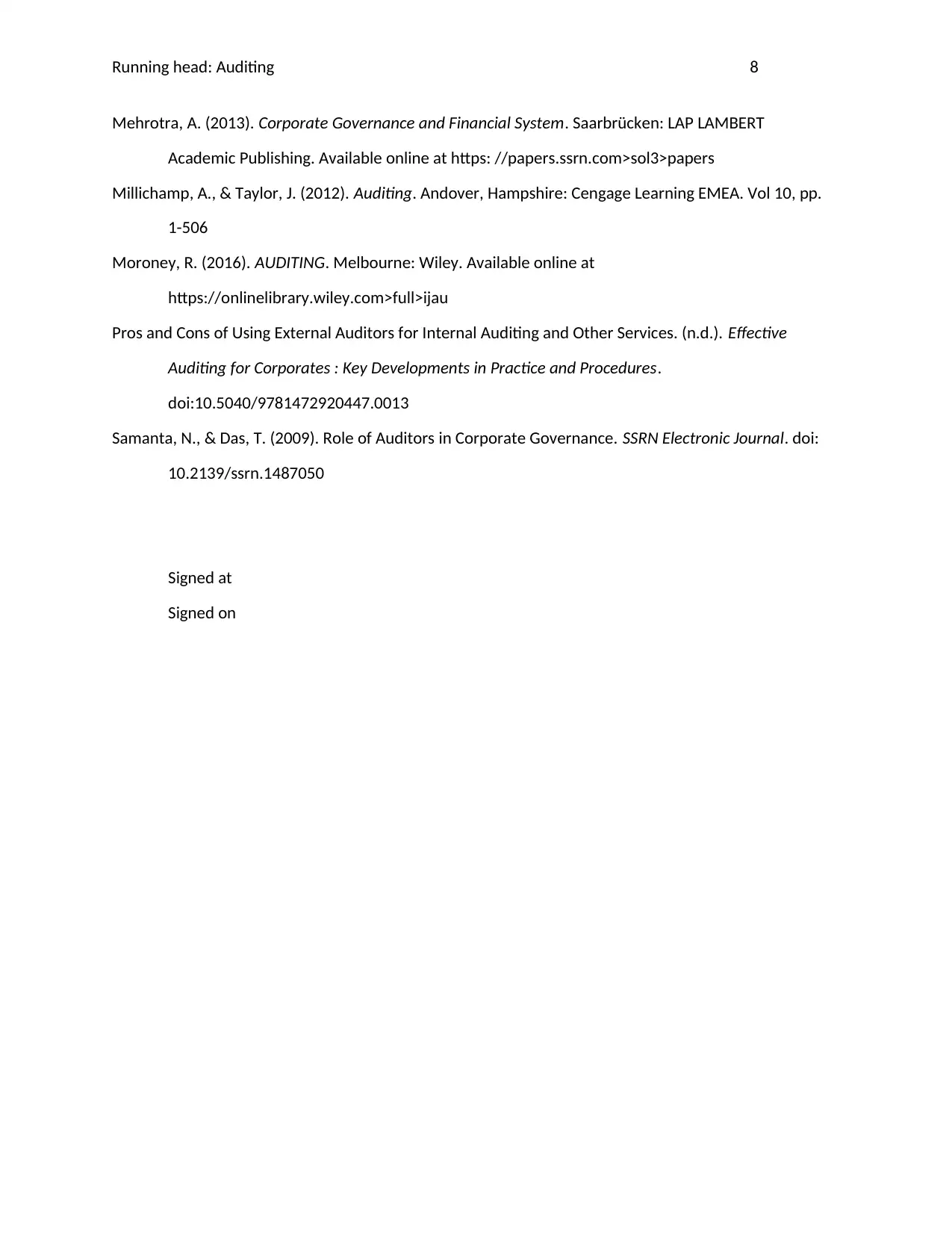
Running head: Auditing 8
Mehrotra, A. (2013). Corporate Governance and Financial System. Saarbrücken: LAP LAMBERT
Academic Publishing. Available online at https: //papers.ssrn.com>sol3>papers
Millichamp, A., & Taylor, J. (2012). Auditing. Andover, Hampshire: Cengage Learning EMEA. Vol 10, pp.
1-506
Moroney, R. (2016). AUDITING. Melbourne: Wiley. Available online at
https://onlinelibrary.wiley.com>full>ijau
Pros and Cons of Using External Auditors for Internal Auditing and Other Services. (n.d.). Effective
Auditing for Corporates : Key Developments in Practice and Procedures.
doi:10.5040/9781472920447.0013
Samanta, N., & Das, T. (2009). Role of Auditors in Corporate Governance. SSRN Electronic Journal. doi:
10.2139/ssrn.1487050
Signed at
Signed on
Mehrotra, A. (2013). Corporate Governance and Financial System. Saarbrücken: LAP LAMBERT
Academic Publishing. Available online at https: //papers.ssrn.com>sol3>papers
Millichamp, A., & Taylor, J. (2012). Auditing. Andover, Hampshire: Cengage Learning EMEA. Vol 10, pp.
1-506
Moroney, R. (2016). AUDITING. Melbourne: Wiley. Available online at
https://onlinelibrary.wiley.com>full>ijau
Pros and Cons of Using External Auditors for Internal Auditing and Other Services. (n.d.). Effective
Auditing for Corporates : Key Developments in Practice and Procedures.
doi:10.5040/9781472920447.0013
Samanta, N., & Das, T. (2009). Role of Auditors in Corporate Governance. SSRN Electronic Journal. doi:
10.2139/ssrn.1487050
Signed at
Signed on
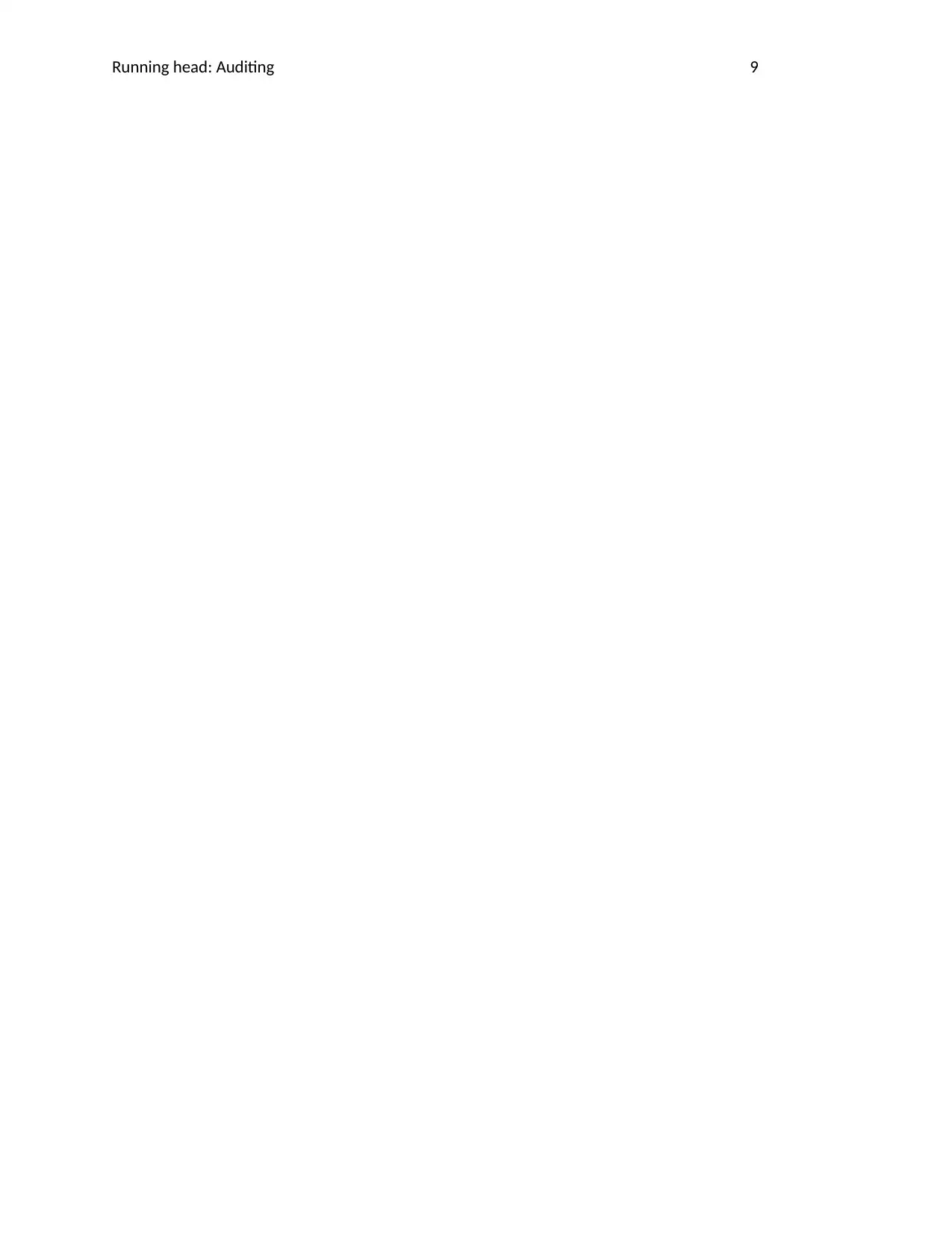
Running head: Auditing 9
⊘ This is a preview!⊘
Do you want full access?
Subscribe today to unlock all pages.

Trusted by 1+ million students worldwide
1 out of 9
Related Documents
Your All-in-One AI-Powered Toolkit for Academic Success.
+13062052269
info@desklib.com
Available 24*7 on WhatsApp / Email
![[object Object]](/_next/static/media/star-bottom.7253800d.svg)
Unlock your academic potential
Copyright © 2020–2025 A2Z Services. All Rights Reserved. Developed and managed by ZUCOL.




